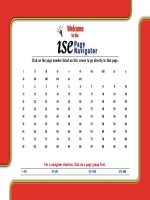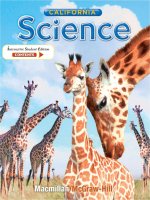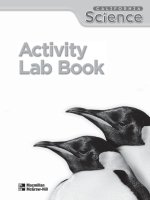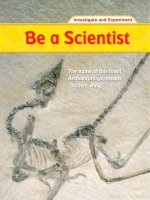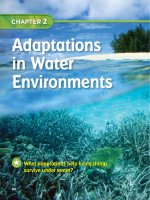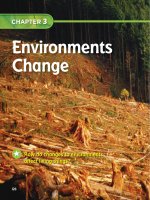- Trang chủ >>
- THPT Quốc Gia >>
- Hóa
California science grade 5 (4)
Bạn đang xem bản rút gọn của tài liệu. Xem và tải ngay bản đầy đủ của tài liệu tại đây (862.24 KB, 16 trang )
Program Authors
Dr. Jay K. Hackett
Professor Emeritus of Earth Sciences
University of Northern Colorado
Dr. Richard H. Moyer
Dr. Gerald F. Wheeler
Executive Director
National Science Teachers Association
Bank Street College of Education
New York, NY
Professor of Science Education and Natural Sciences
University of Michigan–Dearborn
Contributing Authors
Dr. JoAnne Vasquez
Sally Ride Science
San Diego, CA
Elementary Science Education Consultant
NSTA Past President
Member, National Science Board
and NASA Education Board
Mulugheta Teferi, M.A.
Principal, Gateway Middle School
St. Louis Public Schools
St. Louis, MO
Dinah Zike, M.Ed.
Dinah Might Adventures LP
San Antonio, TX
Kathryn LeRoy, M.S.
Dr. Sally Ride
Lucille Villegas Barrera, M.Ed.
Elementary Science Supervisor
Houston Independent School District
Houston, TX
Dr. Stephen F. Cunha
Professor of Geography
Humboldt State University
Arcata, CA
American Museum
of Natural History
New York, NY
Executive Director
Division of Mathematics and Science Education
Miami-Dade County Public Schools, FL
Contributing Writer
Dr. Dorothy J. T. Terman
Albuquerque, NM
Ellen Grace
Science Curriculum Development Consultant
Former K–12 Science and Mathematics Coordinator
Irvine Unified School District, CA
The American Museum of Natural History in New York City is one of the world’s preeminent
scientific, educational, and cultural institutions, with a global mission to explore and interpret
human cultures and the natural world through scientific research, education, and exhibitions. Each year the
Museum welcomes around four million visitors, including 500,000 schoolchildren in organized field trips. It
provides professional development activities for thousands of teachers; hundreds of public programs that
serve audiences ranging from preschoolers to seniors; and an array of learning and teaching resources for
use in homes, schools, and community-based settings. Visit www.amnh.org for online resources.
Students with print disabilities may be eligible to obtain an accessible, audio version of the pupil edition
of this textbook. Please call Recording for the Blind & Dyslexic at 1-800-221-4792 for complete information.
B
Published by Macmillan/McGraw-Hill, of McGraw-Hill Education, a division of The McGraw-Hill Companies, Inc.,
Two Penn Plaza, New York, New York 10121.
Copyright © 2008 by Macmillan/McGraw-Hill. All rights reserved. No part of this publication may be
reproduced or distributed in any form or by any means, or stored in a database or retrieval system,
without the prior written consent of The McGraw-Hill Companies, Inc., including, but not limited to,
network storage or transmission, or broadcast for distance learning.
Science Content Standards for California Public Schools reproduced by permission, California Department
of Education, CDE Press, 1430 N Street, Suite 3207, Sacramento, CA 95814.
is a trademark of The McGraw-Hill Companies, Inc.
Printed in the United States of America
ISBN 0-02-284381-7/6
2 3 4 5 6 7 8 9 (079/055) 10 09 08 07 06
Content
Consultants
Rick MacPherson, Ph.D.
Program Director
The Coral Reef Alliance
San Francisco, CA
Bonnie J. Brunkhorst,
Ph.D.
Barbara Messmer
Scott Hays
Bret Harrison
Roseville City
School District
K-8 Teacher (retired)
Coffee Creek Elementary
Washington Union
School District
Carmel USD
Frank Ledesma
Elementary
Soledad USD
Soledad, CA
Kathy Jones
Abraham Lincoln
Elementary
Simi Valley USD
Simi Valley, CA
Joy Peoples
Riverside USD
Elizabeth Ramsey
Bel Air Elementary
Andrew Rodarte
Easterby Elementary
Department of
Fresno USD
Geological Sciences,
California State University
Rhonda Simard
San Bernardino, CA
Franklin Elementary
Franklin USD
Hector Córdova
Mireles, Ph.D.
Physics Department
California State
Polytechnic University
Pomona, CA
Editorial
Advisory Board
Gus Dalis, Ed.D.
Education Consultant
Torrance, CA
Jeri Starkweather
Calwa Elementary
Fresno USD
Lauri Talbott
Carr Elementary
Torrance USD
Chico USD
Nancy Maguire
Westpark Elementary
Irvine, CA
Bettina Pierce
Elementary Science
Specialist
Irvine USD
Vince Sipkovich
Educator/Science
Consultant/Writer
Huntington Beach, CA
Melissa Smith
Dawn Vollmar
Canyon Lake Middle
School
Foulks Ranch Elementary
Lake Elsinore USD
Elk Grove USD
Lindsay Waterman
Judith Sydner-Gordon
Debbie Drab
Alamo Elementary
Long Beach USD
Sandra S. Wilbur
Carolyn Fong
Los Angeles USD
Chaparral Elementary
Capistrano USD
Canfield Elementary
School
Los Angeles, CA
Joyce Garcia
Janet Yamaguchi
La Seda Elementary
Rowland USD
Nancy Howe
Martin Luther King
Academy
Alisal USD
Linda D. King
Principal, Muscoy
Elementary
San Bernardino City USD
Michael Harris
Teacher
Reviewers
Chico USD
Vicky Ann Buckley
Karen Kohn
Helen Logan Hays
Las Virgenes USD
K-8 Teacher (retired)
Ukiah USD
Coffee Creek Elementary
School District
Carmel USD
U.S. Grant Elementary
Colton Joint USD
Colton, CA
Donna Lowe
Cherryland Elementary
Hayward USD
Jerrie Martin
La Veta Elementary
Orange USD
Orange, CA
Christina Lambie
Highland Elementary
West Contra Costa USD
Richmond, CA
Alice Moomjean
Cortada Elementary
El Monte USD
El Monte, CA
Michelle Orgon
Needham Intermediate
Lodi USD
Lodi, CA
Sue Parsons
Richard Bard Elementary
Hueneme USD
Navelencia Middle School
Pt. Hueneme, CA
Reedley, CA
Task Force
Escondido USD
Joanne Hemmings
Jennifer Weibert
Discovery Science Center
Santa Ana, CA
Susan Gomez Zwiep
Assistant Professor
Science Education
Cal State University
Diane Carnahan
Long Beach
K–12 Alliance/WestEd
David M. Harris
Dennis Hatland
Sharon Pendola
St. Alban’s Country Day
School
Roseville, CA
Lisa Robinson
Marengo Elementary
South Pasadena USD
South Pasadena, CA
Roberta Sanchez
Lindberg Schweitzer
Elementary
San Diego USD
San Diego, CA
Naomi Griswold
Rio Hondo Elementary
Downey USD
Downey, CA
NBCT
Los Angeles USD
iii
iv
What is Science? . . . . . . . . . . . . . . . . . . . . . . . . . . . . . . . 2
Observation . . . . . . . . . . . . . . . . . . . . . . . . . . . . . . . . . . . 4
Question and Hypothesis . . . . . . . . . . . . . . . . . . . . . . . 6
Experiment . . . . . . . . . . . . . . . . . . . . . . . . . . . . . . . . . . . 8
Collect Data . . . . . . . . . . . . . . . . . . . . . . . . . . . . . . . . . . 10
Conclusion . . . . . . . . . . . . . . . . . . . . . . . . . . . . . . . . . . . 12
Forming a Hypothesis . . . . . . . . . . . . . . . . . . . . . . . . . 14
Recording Data . . . . . . . . . . . . . . . . . . . . . . . . . . . . . . . 15
Testing a Hypothesis . . . . . . . . . . . . . . . . . . . . . . . . . . 16
Evaluating Evidence . . . . . . . . . . . . . . . . . . . . . . . . . . . 17
Asking New Questions . . . . . . . . . . . . . . . . . . . . . . . . . 18
This student is
observing a
changing color. C
v
CHAPTER 1
Earth’s Ecosystems . . . . . . . . . . . . . . . . . . . . . . . . . . . 20
Literature: Behind the Redwood Curtain . . . . . . . . . . . . . . 22
Lesson 1
Introduction to Earth’s Ecosystems . . . . . . . . . 24
Inquiry Skill Builder: Compare . . . . . . . . . . . . . 38
Lesson 2 Photosynthesis: The Basic Process of Life . . . . 40
Writing in Science . . . . . . . . . . . . . . . . . . . . . . . . 52
Lesson 3 Microscopic Organisms on Earth . . . . . . . . . . . 54
Reading in Science . . . . . . . . . . . . . . . . . . . . . . . 64
Lesson 4 Earth’s Food Chains, Webs, and Pyramids . . . 66
Math in Science . . . . . . . . . . . . . . . . . . . . . . . . . . 78
Lesson 5 Earth’s Cycles for Life . . . . . . . . . . . . . . . . . . . . . 80
Inquiry Investigation . . . . . . . . . . . . . . . . . . . . . . 90
Chapter 1 Review and Test Practice . . . . . . . . . . . . . . . . . . . 92
B Animals and plants share a lake ecosystem.
vi
CHAPTER 2
Earth’s Land and Water . . . . . . . . . . . . . . . . . . . . . . 96
Literature: Mojave . . . . . . . . . . . . . . . . . . . . . . . . . . . . . . . . . . 98
Lesson 1
Earth’s Land Biomes . . . . . . . . . . . . . . . . . . . . . 100
Inquiry Skill Builder: Sequence . . . . . . . . . . . . 1 1 6
Lesson 2 Earth’s Water Ecosystems . . . . . . . . . . . . . . . . 1 1 8
Reading in Science . . . . . . . . . . . . . . . . . . . . . . 128
Inquiry Investigation . . . . . . . . . . . . . . . . . . . . . 130
Lesson 3 Ecosystems in California. . . . . . . . . . . . . . . . . . 132
Writing in Science . . . . . . . . . . . . . . . . . . . . . . . 148
Math in Science . . . . . . . . . . . . . . . . . . . . . . . . . 149
Chapter 2 Review and Test Practice . . . . . . . . . . . . . . . . . 150
Frozen Frogs . . . . . . . . . . . . . . . . . . . . . . . . . . . 154
Careers in Science . . . . . . . . . . . . . . . . . . . . . . . . . . . . . . . . 156
B The members of this wolf pack live in the taiga.
vii
CHAPTER 3
Heat Energy . . . . . . . . . . . . . . . . . . . . . . . . . . . . . . . . . 158
Literature: Sun-Powered Speed . . . . . . . . . . . . . . . . . . . . . 160
Lesson 1
Heat Flow . . . . . . . . . . . . . . . . . . . . . . . . . . . . . . 162
Inquiry Skill Builder: Experiment. . . . . . . . . . . 172
Lesson 2 Waves . . . . . . . . . . . . . . . . . . . . . . . . . . . . . . . . . 174
Reading in Science . . . . . . . . . . . . . . . . . . . . . . 184
Lesson 3 Fuels: Our Major Energy Source . . . . . . . . . . . 186
Writing in Science . . . . . . . . . . . . . . . . . . . . . . . 196
Math in Science . . . . . . . . . . . . . . . . . . . . . . . . . 197
Lesson 4 Heat Transfer in Solids and Fluids . . . . . . . . . . 198
Inquiry Investigation . . . . . . . . . . . . . . . . . . . . . 206
Chapter 3 Review and Test Practice . . . . . . . . . . . . . . . . . 208
B This rocket must burn a tremendous amount
of fuel to escape Earth’s atmosphere.
viii
CHAPTER 4
Energy in the Earth System . . . . . . . . . . . . . . . . . 212
Literature: Lasers: A Scientific Breakthrough . . . . . . . . . 214
Lesson 1
Electromagnetic Spectrum . . . . . . . . . . . . . . . 2 1 6
Inquiry Skill Builder: Form a Hypothesis . . . . 226
Lesson 2 Solar Radiation. . . . . . . . . . . . . . . . . . . . . . . . . . 228
Reading in Science . . . . . . . . . . . . . . . . . . . . . . 238
Lesson 3 The Power of Convection Currents . . . . . . . . . 240
Writing in Science . . . . . . . . . . . . . . . . . . . . . . . 252
Math in Science . . . . . . . . . . . . . . . . . . . . . . . . . 253
Inquiry Investigation . . . . . . . . . . . . . . . . . . . . . 254
Chapter 4 Review and Test Practice . . . . . . . . . . . . . . . . . 256
Out of Sight! . . . . . . . . . . . . . . . . . . . . . . . . . . . . 260
Careers in Science . . . . . . . . . . . . . . . . . . . . . . . . . . . . . . . . 262
C A prism shows the
“rainbow” of colors
that make up the
spectrum of visible
light.
ix
CHAPTER 5
Plate Tectonics and Earth’s Structure . . . . . . . 264
Literature: Cracked Plates . . . . . . . . . . . . . . . . . . . . . . . . . . 266
Lesson 1
Earth’s Moving Plates . . . . . . . . . . . . . . . . . . . . 268
Inquiry Skill Builder: Draw Conclusions . . . . . 278
Lesson 2 Plate Tectonics: A Unifying Theory . . . . . . . . 280
Inquiry Skill Builder: Make a Model . . . . . . . . . 294
Lesson 3 Earthquakes . . . . . . . . . . . . . . . . . . . . . . . . . . . . 296
Writing in Science . . . . . . . . . . . . . . . . . . . . . . . 306
Math in Science . . . . . . . . . . . . . . . . . . . . . . . . . 307
Lesson 4 Volcanoes . . . . . . . . . . . . . . . . . . . . . . . . . . . . . . 308
Inquiry Investigation . . . . . . . . . . . . . . . . . . . . . 322
Lesson 5 How Plate Tectonics Affects California . . . . . 324
Reading in Science . . . . . . . . . . . . . . . . . . . . . . 332
Chapter 5 Review and Test Practice . . . . . . . . . . . . . . . . . 334
CHAPTER 6
Shaping Earth’s Surface . . . . . . . . . . . . . . . . . . . . . 338
Literature: Surf vs. Sand . . . . . . . . . . . . . . . . . . . . . . . . . . . 340
Lesson 1
Atmospheric Pressure, Temperature,
and Weather . . . . . . . . . . . . . . . . . . . . . . . . . . . . 342
Inquiry Skill Builder: Analyze Data . . . . . . . . . 354
Lesson 2 Weathering, Erosion, and Deposition . . . . . . . 356
Writing in Science . . . . . . . . . . . . . . . . . . . . . . . 366
Lesson 3 Rivers and Streams . . . . . . . . . . . . . . . . . . . . . . 368
Reading in Science . . . . . . . . . . . . . . . . . . . . . . 378
Lesson 4 Beaches and Wave Erosion . . . . . . . . . . . . . . . 380
Inquiry Investigation . . . . . . . . . . . . . . . . . . . . . 388
x
Lesson 5 Changing Habitats . . . . . . . . . . . . . . . . . . . . . . . 390
Math in Science . . . . . . . . . . . . . . . . . . . . . . . . . 404
Chapter 6 Review and Test Practice . . . . . . . . . . . . . . . . . 406
CHAPTER 7
Earth’s Resources. . . . . . . . . . . . . . . . . . . . . . . . . . . . 410
Literature: Plug Into the Moon . . . . . . . . . . . . . . . . . . . . . . 41 2
Lesson 1
Sources of Energy . . . . . . . . . . . . . . . . . . . . . . . 414
Inquiry Skill Builder: Communicate . . . . . . . . 426
Lesson 2 Renewable and Nonrenewable Resources. . . 428
Reading in Science . . . . . . . . . . . . . . . . . . . . . . 440
Inquiry Investigation . . . . . . . . . . . . . . . . . . . . . 442
Lesson 3 Uses of Resources . . . . . . . . . . . . . . . . . . . . . . . 444
Writing in Science . . . . . . . . . . . . . . . . . . . . . . . 456
Math in Science . . . . . . . . . . . . . . . . . . . . . . . . . 457
Chapter 7 Review and Test Practice . . . . . . . . . . . . . . . . . 458
Understanding Earthquakes . . . . . . . . . . . . . . 462
Careers in Science . . . . . . . . . . . . . . . . . . . . . . . . . . . . . . . . 464
B Oil field in Huntington Beach, California
xi
Earth’s Ecology
CHAPTER 1
Plants as Water Filters . . . . . . . . . . 125
Explore Activities
Do different ecosystems contain
different organisms? . . . . . . . . . . . . . 25
A California Food Web . . . . . . . . . . 143
How does light affect plants? . . . . . 41
Skill Builders and Investigations
Sequence. . . . . . . . . . . . . . . . . . . . . . 116
What is an estuary? . . . . . . . . . . . . . 130
What can you see through a
microscope? . . . . . . . . . . . . . . . . . . . . 55
How can you model a food chain? . 67
Earth’s Energy
How does water recycle itself? . . . . 81
CHAPTER 3
Quick Labs
Testing Soil pH . . . . . . . . . . . . . . . . . . 33
Explore Activities
How can you measure
heat flow? . . . . . . . . . . . . . . . . . . . . . 163
Leaves . . . . . . . . . . . . . . . . . . . . . . . . . 47
Observing Protists . . . . . . . . . . . . . . . 61
Your Food Chain . . . . . . . . . . . . . . . . 71
How can you change the sound
a string makes? . . . . . . . . . . . . . . . . 175
Fertilizers . . . . . . . . . . . . . . . . . . . . . . . 87
How can you use the energy
of the Sun? . . . . . . . . . . . . . . . . . . . . 187
Skill Builders and Investigations
Compare . . . . . . . . . . . . . . . . . . . . . . .38
How does heat flow from one
material to another? . . . . . . . . . . . . 199
What factors affect the carbon,
water, and nitrogen cycles? . . . . . . 90
Quick Labs
Different Objects,
Different Temperatures . . . . . . . . 169
CHAPTER 2
Explore Activities
What are Earth’s biomes like? . . . . 101
What are water ecosystems like? . 119
What are California’s
ecosystems? . . . . . . . . . . . . . . . . . . . 133
Quick Labs
Endangered Species . . . . . . . . . . . . 107
xii
Traveling Sound Waves . . . . . . . . . 181
What materials can reduce
friction? . . . . . . . . . . . . . . . . . . . . . . 193
Which warms faster? . . . . . . . . . . 204
Skill Builders and Investigations
Experiment . . . . . . . . . . . . . . . . . . . . 172
What happens when Earth’s
surface breaks? . . . . . . . . . . . . . . . .297
What are conduction and
convection? . . . . . . . . . . . . . . . . . . . 206
How can you make a model volcano
erupt? . . . . . . . . . . . . . . . . . . . . . . . . 309
CHAPTER 4
How do plate movements affect
California? . . . . . . . . . . . . . . . . . . . . .325
Explore Activities
Which material best heats
water? . . . . . . . . . . . . . . . . . . . . . . . . 217
Quick Labs
Model Plate Movement. . . . . . . . . . . 275
How can light energy create
motion? . . . . . . . . . . . . . . . . . . . . . . .229
Measuring Density . . . . . . . . . . . . . .285
How does heat move in liquids
and gases? . . . . . . . . . . . . . . . . . . . . 241
Cooling Candle Lava . . . . . . . . . . . . 319
Quick Labs
Distance and Energy . . . . . . . . . . . .223
Solar Still . . . . . . . . . . . . . . . . . . . . . .233
Expanding and Contracting Air . .245
Skill Builders and Investigations
Form a Hypothesis . . . . . . . . . . . . .226
Earthquake Safety . . . . . . . . . . . . . . 301
Folded Mountains . . . . . . . . . . . . . .329
Skill Builders and Investigations
Draw Conclusions . . . . . . . . . . . . . .278
Make a Model . . . . . . . . . . . . . . . . . 294
What are some of the characteristics
of volcanic rock? . . . . . . . . . . . . . . .322
CHAPTER 6
What can convection currents
do? . . . . . . . . . . . . . . . . . . . . . . . . . . 254
Explore Activities
Where does precipitation come
from? . . . . . . . . . . . . . . . . . . . . . . . . 343
Earth’s Structure
How does the steepness of a slope
affect stream erosion? . . . . . . . . . .357
CHAPTER 5
Explore Activities
Are the continents moving? . . . . .269
How can you make a model
of Earth’s interior? . . . . . . . . . . . . . . 281
How can you map
a watershed? . . . . . . . . . . . . . . . . . 369
What is sand? . . . . . . . . . . . . . . . . . . 381
How do volcanic eruptions
affect habitats? . . . . . . . . . . . . . . . . 391
xiii
Quick Labs
Measuring Humidity . . . . . . . . . . . 349
Layers of Sediment . . . . . . . . . . . . . 361
Changing the Land . . . . . . . . . . . . .375
How Waves Affect Beaches . . . . .385
Local Natural Disaster . . . . . . . . . . 399
Skill Builders and Investigations
Analyze Data . . . . . . . . . . . . . . . . . 354
What can change a river? . . . . . . 388
CHAPTER 7
Explore Activities
What factors affect the efficiency
of a solar oven? . . . . . . . . . . . . . . . . 415
How energy efficient are different
types of lightbulbs? . . . . . . . . . . . . 429
What are objects made of? . . . . . 445
Quick Labs
The Power of Water . . . . . . . . . . . .423
Fuel Supply . . . . . . . . . . . . . . . . . . . 433
Sources of Clothes. . . . . . . . . . . . . . 451
Skill Builders and Investigations
Communicate . . . . . . . . . . . . . . . . . 426
How can you classify a renewable
resource? . . . . . . . . . . . . . . . . . . . . . 442
D This student is making a model
that shows a volcano erupting.
xiv
California Science Content Standards . . . . . . . . . . . . . . . 466
Science Handbook
Units of Measurement . . . . . . . . . . . . . . . . . . . . . . . . 468
Measure Time . . . . . . . . . . . . . . . . . . . . . . . . . . . . . . . 470
Measure Length. . . . . . . . . . . . . . . . . . . . . . . . . . . . . . 47 1
Measure Mass . . . . . . . . . . . . . . . . . . . . . . . . . . . . . . . 472
Measure Volume . . . . . . . . . . . . . . . . . . . . . . . . . . . . . 473
Measure Weight/Force . . . . . . . . . . . . . . . . . . . . . . . 474
Measure Temperature . . . . . . . . . . . . . . . . . . . . . . . . 475
Use a Hand Lens . . . . . . . . . . . . . . . . . . . . . . . . . . . . . 476
Use a Microscope . . . . . . . . . . . . . . . . . . . . . . . . . . . . 477
Use Calculators . . . . . . . . . . . . . . . . . . . . . . . . . . . . . . 478
Use Computers . . . . . . . . . . . . . . . . . . . . . . . . . . . . . . 480
Make Graphs to Organize Data . . . . . . . . . . . . . . . . . 482
Make Tables to Organize Information . . . . . . . . . . . 484
Make Charts to Organize Information . . . . . . . . . . . 485
Make Maps to Show Information . . . . . . . . . . . . . . . 486
. . . . . . . . . . . . . . . . . . . . . . . . . . . . . . . . . . . . . . . 487
Glossary . . . . . . . . . . . . . . . . . . . . . . . . . . . . . . . . . . . . . . . . . 4 9 1
Index. . . . . . . . . . . . . . . . . . . . . . . . . . . . . . . . . . . . . . . . . . . . . 511
xv
In the Classroom
• Read all of the directions.
Make sure you understand them.
Be Careful,”
When you see “
follow the safety rules.
• Listen to your teacher for special
safety directions. If you do not
understand something, ask
for help.
• Wash your hands with soap and
water before an activity.
• Be careful around a hot plate.
Know when it is on and when it
is off. Remember that the plate
stays hot for a few minutes after
it is turned off.
• Wear a safety apron if you work
with anything messy or anything
that might spill.
• Clean up a spill right away,
or ask your teacher for help.
• Tell your teacher if something
breaks. If glass breaks, do not
clean it up yourself.
• Wear safety goggles when your
teacher tells you to wear them.
Wear them when working with
anything that can fly into your
eyes or when working with
liquids.
xvi
• Keep your hair and clothes away
from open flames. Tie back long
hair, and roll up long sleeves.
• Keep your hands dry around
electrical equipment.
• Do not eat or drink anything
during an experiment.
• Put equipment back the way your
teacher tells you to.
• Dispose of things the way your
teacher tells you to.
• Clean up your work area after
an activity, and wash your hands
with soap and water.
In the Field
• Go with a trusted adult—such
as your teacher, or a parent or
guardian.
• Do not touch animals or plants
without an adult’s approval. The
animal might bite. The plant
might be poison ivy or another
dangerous plant.
Responsibility
• Treat living things, the
environment, and one another
with respect.

